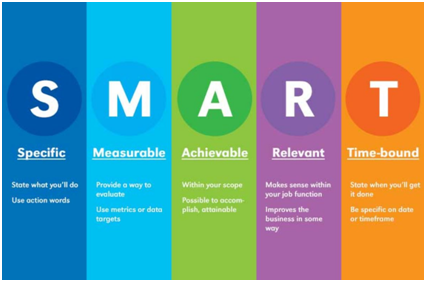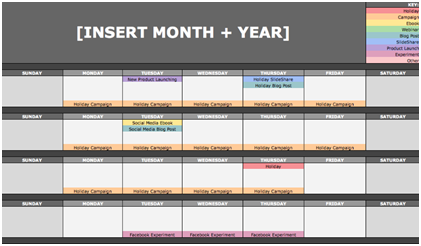Content Is King – this was the title of an article that Bill Gates wrote in 1996. And what he advocated back then continues to be absolutely true in 2020 as well. However, just developing content will get you nowhere. You also need to have a content marketing plan handy.
Whether you are new to this or have been using content marketing strategy for a while, revisiting the plan is never a bad idea.
So, in this fast-paced world, here’s how to create a content marketing plan in just 7 days. These steps are easy to understand and implement and will help you achieve your business goals with more ease than ever before.
Day 1: Set Your Goals and Objectives
Let’s start with the basic stuff. Without an end goal, you may get confused and lost during the journey. And so, before you start, set a content marketing goal.

To set a goal, you need to simply answer ‘What is your purpose with this plan?’ If your answer sounds similar to “content development is the trend”, then think again.
You do not need to brainlessly follow what others are doing, but find a meaning behind your actions instead.
Setting your goal is important to:
- Know what you want to achieve
- Understand the value you will offer
- Determine the voice of the content across all platforms
- Facilitate the direction of the content
Some of the most common goals I have experienced for content marketing strategy are discoverability, industry authority, and building community. So, decide what is it that you want to achieve.
Additional Tip: While defining content goals, always try opting for ‘SMART’ Goals.
SMART Goals stands for:
- S – Specific
- M – Measurable
- A – Attainable
- R – Relevant
- T – Time-bound
Here’s an example of a SMART goal:
Instead of setting your goal as ‘increase blog revenue’, you can employ the SMART Goal rule and define the goal as ‘Increase blog revenue by 30% by the third quarter of 2021’.
Day 2: Understand Your Target Audience
Once you have a goal set, the next step in the content creation plan is to zero in on the strategy. You cannot directly jump to producing content. You need a bit of planning to start with. So, start with understanding your target audience and defining them.

How are you going to do that?
Step 1: Who are they?
Start with defining your target audience. Get a pen and paper, and start writing about what you know about your audience.
For example, if you are selling designer clothes, your audience would be ‘people looking for clothes’, right? Wrong. Here’s the problem, loud and clear. You cannot go on targeting each and everyone on this planet, just because everyone needs clothes and buys them. You need to be specific about the audience.
Define if you are selling clothes for:
- Kids/Women/Men
- Casuals/Formals/Party Wear
- Low-range/Mid-range/High-range
And so on…
After all, a person whose monthly salary is around 20K won’t be interested in high-range party wear clothes that cost them 5-7K for a piece. This is why, it is important to understand, define, and target your audience.
Step 2: What are their struggles?
The next step for defining your audience is to understand their struggles. Only then you can offer a solution to them.
Let’s go with our example of the clothing line. The struggles of your audience may include:
- Keeping up-to-date with current trends
- Colors and patterns as per seasonal change
- Combining accessories with their outfit styles
And so on…
Now, once you know your audience’s problems, you can start with content creation that offers the solutions. And this is why defining the audience is very important in content marketing planning.
Day 3: Competitor Analysis
By now, you should have a clear idea of what objectives you are going to achieve and brief information about your ideal customer. Before you jump in and start to create the content, make sure you do a brief competitor analysis too.
Why is it important? The answer is simple – to know what is your competitor up to and what your audience likes to perceive.
How you will do the competitor analysis?
- Analyse your competitor’s blog
- Check their social media profile
- Perform SWOT analysis
SWOT Analysis Can help you understand your competitor better and prepare a smarter content plan.
S – Know their Strengths and check if your quality matches that.
W – Know their Weaknesses and use your content to target those.
O – Check if there are any Opportunities like markets or alliances they do not serve currently.
T – Understand Threats like negative brand sentiments or changes in customers’ attitudes.
Day 4: Generating Content Ideas and Keyword Research
Now comes the main part of getting started with the content. However, don’t just produce it yet. You know your goals, and the preferences of your audience, and have analysed your competitors. Combine all these results, and get into a brainstorming session with your team.

To generate content ideas:
- Identify topics your audience will be interested in
- Conduct hot keyword searches related to your industry
- Explore Quora and Reddit to check what people are asking
- Check Hashtags and Google Trends for ideas
And so on…
You can use certain tools to help you generate content ideas too. Some of them are:
- Buzzsumo
- Ahrefs https://ahrefs.com/
- Google Alerts
- UberSuggest
- SimilarWeb
- Feedly
- Portent’s Content Idea Generator
Once you have several content ideas to work on, make sure that you do your keyword research too. This simplifies the process and gives you a breather time while producing content. And I hope that you know how important the role of keywords is in the content marketing industry till now. So, start with your research.
Day 5: Make a Content Schedule
Once you are done with generating ideas and researching for keywords, the next step is to make a content calendar. This is an important step that can help you churn out valuable content consistently and at the right frequency.

Your content schedule will play as a basic guide to producing content. It should include:
- The interval between two content pieces
- Consistent frequency
- Type of content
While finalising the content calendar, consider the resources that are available to you, for your convenience. So, do not make a schedule with a content piece every alternate day if you do not have writers, editors, and graphic designers to produce it that frequently.
Day 6: Start Creating Content
You have everything handy now – so the next step is to start creating content. You can do that by getting into your reader’s head. We are already done with target audience research and generating ideas, so you should have a basic idea of the concepts.
However, to start with, you can choose one of the five basic thoughts behind a blog:
- Entertainment
- Inspiration
- Education
- Research
- Creating Connection
Once you have conceptualized your thought process, keep some other things in mind while creating content, like:
- Voice of content (interactive, educational, fun, etc.)
- Style of writing (formal, informal, casual, etc.)
- Type of content (blogs, long-form blogs, infographics, etc.)
Also Read: Guide to Choosing from 12 Different Content Marketing Formats
Day 7: Promoting Your Content
Just producing your content and publishing it isn’t enough. You also need to start sharing it on platforms where your ideal audience is.
For this, you can start by asking yourself:
- On which platforms does your potential customer spend most of their time?
- Where does your ideal customer prefer getting solutions for their problems?
- Which platform is best suited for your business and industry?
The answer to these three questions will help you pick the right platform for promoting your content. Apart from social media platforms, you can also use emailers and newsletters to promote your content. In short, there are many options available -you simply need to try them and keep experimenting.
Also Read: How to Write a Case Study to Convince and Convert Customers ?
To Conclude
So, that’s how you formulate and establish a content marketing plan. Follow each of the steps above and in the order suggested to devise a plan that will work wonders for your business. However, that’s not all. You will need to revise and reformulate your content plan every now and then to check if they are working in-line with your goals.






